Qualcomm Snapdragon S4 (Krait) Performance Preview - 1.5 GHz MSM8960 MDP and Adreno 225 Benchmarks
by Brian Klug & Anand Lal Shimpi on February 21, 2012 3:01 AM EST- Posted in
- Smartphones
- Snapdragon
- Qualcomm
- Adreno
- Krait
- Mobile
Power Measurements using Trepn
Measuring power draw is an interesting unique capability of Qualcomm's MDPs. Using their Trepn Profiler software and measurement hardware integrated into the MDP, we can measure a number of different power rails on the device, including power draw from each CPU core, the digital core (including video decoder and modem) and a bunch of other measures.
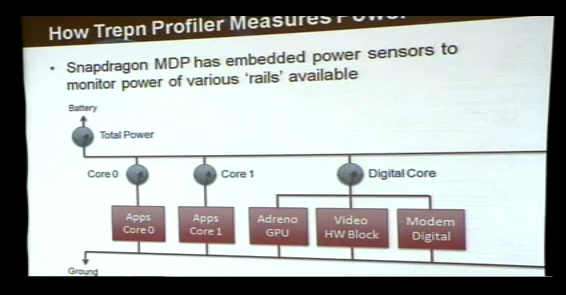
Measuring and keeping track of how different SoCs consumer power is something we've wanted to do for a while, and at least under the Qualcomm MDP umbrella at this point it's possible to measure right on the device.
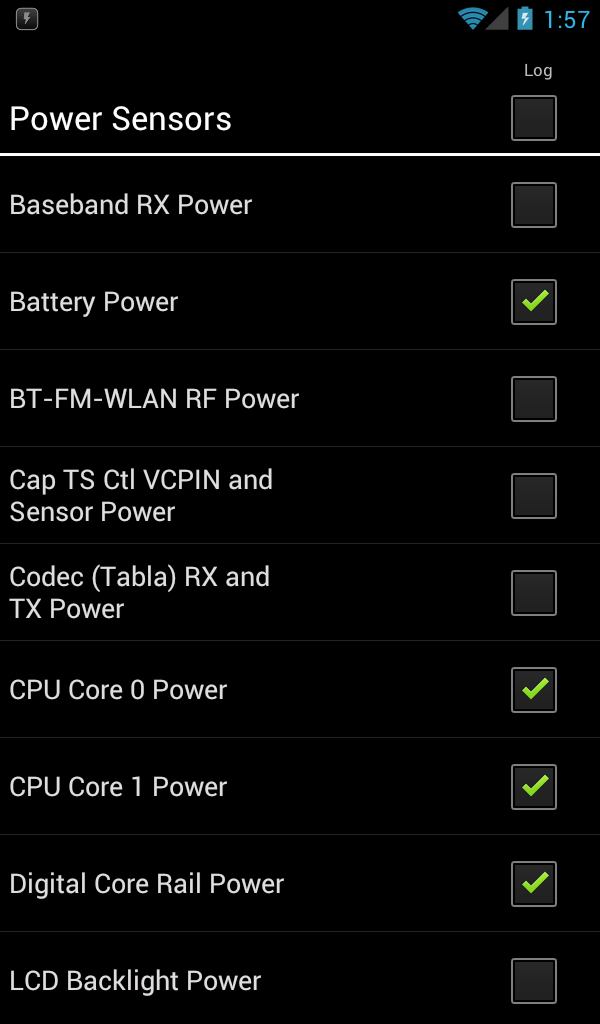
The original goal was to compare power draw on 45nm MSM8660 versus 28nm MSM8960, however we encountered stability issues with Trepn profiler on the older platform that are still being resolved. Thankfully it is possible to take measures on MSM8960, and for this we turned to a very CPU intensive task that would last long enough to get a good measure, and also load both cores so we can see how things behave. That test is the Moonbat Benchmark, which is a web-worker wraper of the sunspider 0.9 test suite. We fired up a test consisting of 4 workers and 50 runs inside Chrome beta (which is web-worker enabled), and profiled using Trepn.
If you squint at the graph, you can see that one Krait core can use around 750 mW at maximum load. I didn't enable the CPU frequency graph (just to keep things simple above) but is 750 mW number happens right at 1.5 GHz. The green spikes from battery power are when we're drawing more than the available current from USB - this is also why you see devices sometimes discharge even when plugged in. There's an idle period at the end that I also left visible - you can see how quickly Qualcomm's governor suspends the second core completely after our moonbat test finishes running.
Here's another run of moonbat on Chrome Beta where we can see the same behavior, but zoomed in a bit better - each Krait core will consume anywhere between 450 mW and 750 mW depending on the workload, which does change during our run while V8 does its JIT compilation and Chrome dispach things to each CPU.
The next big question is obviously - well how much does GPU contribute to power drain? The red "Digital Core Rail Power" lines above include the Adreno 225 GPU, video decode, and "modem digital" blocks. Cellular is disabled on the MDP MSM8960, and we're not decoding any video, so in the right circumstances we can somewhat isolate out the GPU. To find out, I profiled a run of GLBenchmark Egypt on High settings (which is an entirely GPU compute bound test) and let it run to completion. You can see how the digital rail bounces between 800 mW and 1.2 W while the test is running. Egypt's CPU portions are pretty much single-threaded as well, as shown by the yellow and green lines above.
Another interesting case is what this looks like when browsing the web. I fired up the analyzer and loaded the AnandTech homepage followed by an article, and scrolled the page in the trace above. Chrome and "Browser" on Android now use the GPU for composition and rendering the page, and you can see the red line in the plot spike up when I'm actively panning and translating around on the page. In addition, the second CPU core only really wakes up when either loading the page and parsing HTML.
One thing we unfortunately can't measure is how much power having the baseband lit up on each different air interface (CDMA2000 1x, EV-DO, WCDMA, LTE, etc.) consumes, as the MDP MSM8960 we were sampled doesn't have cellular connectivity enabled. This is something that we understand in theory (at least for the respective WCDMA and LTE radio resource states), but remains to be empirically explored. It's unfortunate that we also can't compare to the MDP MSM8660 quite yet, but that might become possible pretty quickly.


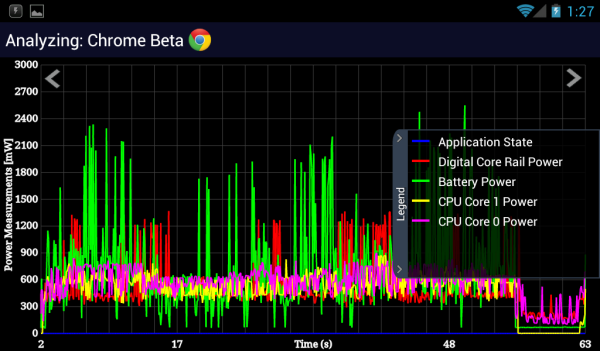
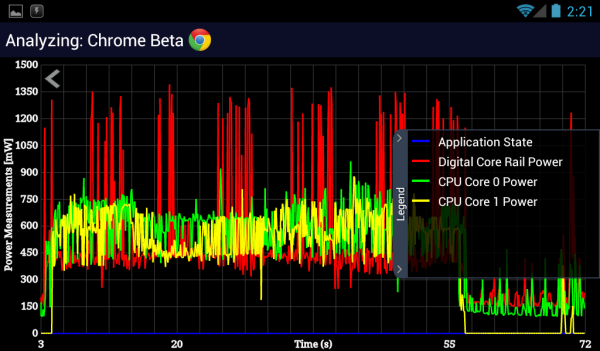
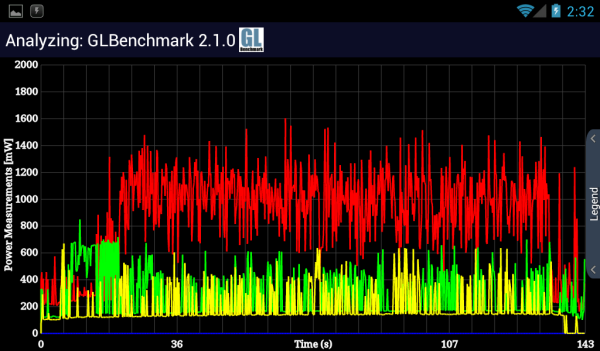
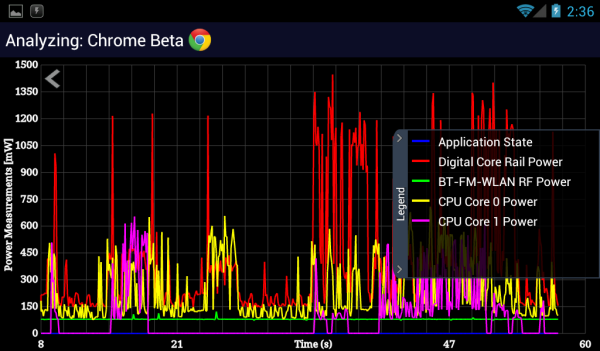








86 Comments
View All Comments
BaronMatrix - Tuesday, February 21, 2012 - link
We can look at the perf of CedarTrail or Ivy Blossom or whatever. Since Intel has said they are more so competing with Qualcomm. And this is only at 1.5GHz. When the 2.5Ghz chips come out with the new Adreno (Former ATi GPU), everyone will have to pack up and go home.iwod - Tuesday, February 21, 2012 - link
The rumors of Apple A5X leads some to suggest next iPad would not be 28nm SoC. So this prove we may still have chance of 28nm SoC coming in next iPad.Krait is bringing A15 level performance while being on a A9 class core?? Sorry i must be missing something. Or Since Krait is designed by Qualcomm A9 and A15 naming doesn't matter? (o.O)
No Mention of comparison to Intel newest Atom?
infra_red_dude - Tuesday, February 21, 2012 - link
Correct, Krait cannot be directly compared to A9 or A15 architecture. I think calling Krait contemporary to A15 is more correct than "A15/9-class" CPU.snoozemode - Tuesday, February 21, 2012 - link
It's really about time you can plug in your mobile to computer screen and run the Tablet UI, preferably at native resolution. Don't know what I would need this processing power to otherwise.tipoo - Tuesday, February 21, 2012 - link
This is very obviously faster than something like the Tegra 3 in single or dual threaded performance, I wonder how many apps take advantage of more than two threads on Android or iOS? I'm guessing for the foreseeable future faster duals will win out.remixfa - Tuesday, February 21, 2012 - link
Can Brian Klug & Anand Lal Shimpi please clarify for me which version of the SGS2 is being used? Its a very pertinent question. Is it the i9000 with the 1.2ghz Exynos chip or the American Hercules T989/Skyrocket variants that have the lesser Snapdragon 1.5ghz chips in them.Judging from the benchmarks, it really makes me think its the hercules/skyrocket. That really needs to be clarified, since unfortunately not all SGS2s are created equal.
Brian Klug - Tuesday, February 21, 2012 - link
The SGS2 used in the article is the UK SGS2 with Exynos 4210 inside.-Brian
larry6hi5 - Tuesday, February 21, 2012 - link
On page 1 of the article, the first table gives the MSM8660 as running at 1.5 GHz. Shouldn't this be 1.0 GHz?Brian Klug - Tuesday, February 21, 2012 - link
That's because the MSM8660 is indeed at 1.5 GHz :)If you go back to our original MDP article we note it there: http://www.anandtech.com/show/4243/
And also the official MDP MSM8660 page: https://developer.qualcomm.com/develop/development...
-Brian
ncb1010 - Tuesday, February 21, 2012 - link
"Even at its lower native resolution, Apple's iPhone 4S is unable to outperform the MSM8960 based MDP here"1024 x 600 = 614,400 pixels
960 x 640 = 614,400 pixels
There is no basis for saying the iPhone 4S has a lower resolution than this MDP being evaluated.